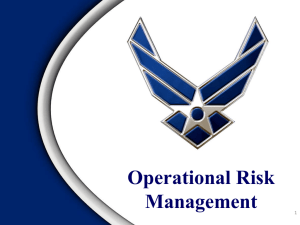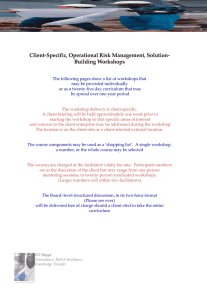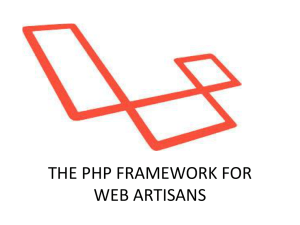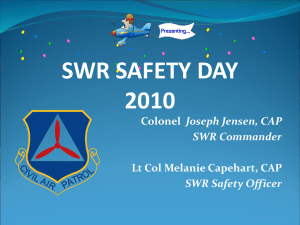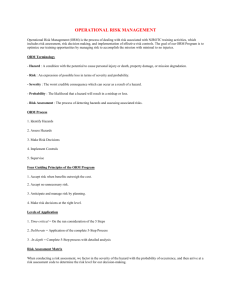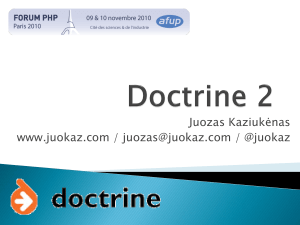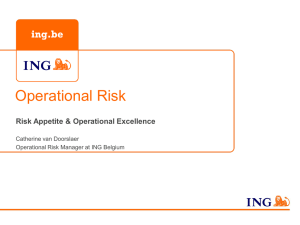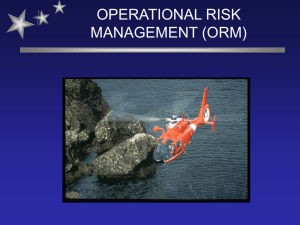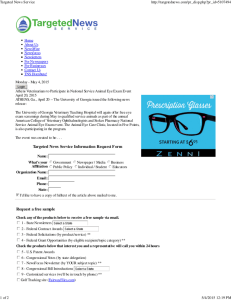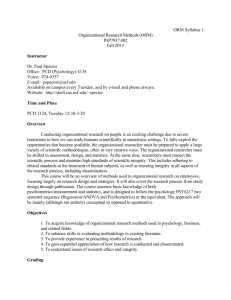BY ORDER OF THE COMMANDER AIR FORCE MATERIEL
advertisement
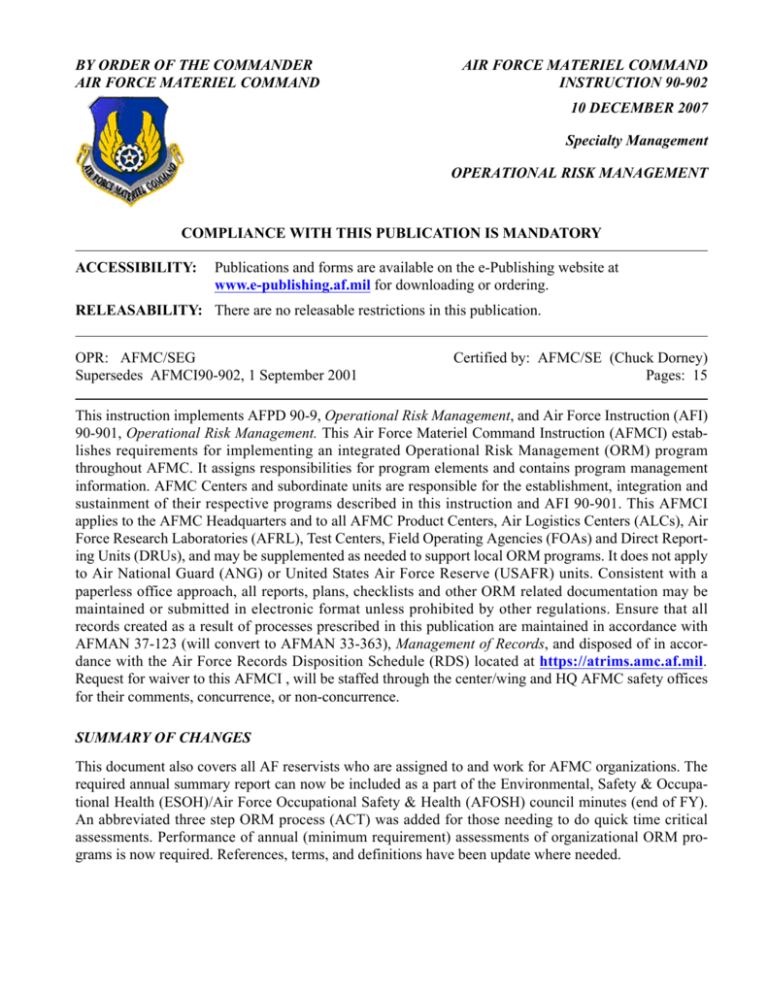
BY ORDER OF THE COMMANDER AIR FORCE MATERIEL COMMAND AIR FORCE MATERIEL COMMAND INSTRUCTION 90-902 10 DECEMBER 2007 Specialty Management OPERATIONAL RISK MANAGEMENT COMPLIANCE WITH THIS PUBLICATION IS MANDATORY ACCESSIBILITY: Publications and forms are available on the e-Publishing website at www.e-publishing.af.mil for downloading or ordering. RELEASABILITY: There are no releasable restrictions in this publication. OPR: AFMC/SEG Supersedes AFMCI90-902, 1 September 2001 Certified by: AFMC/SE (Chuck Dorney) Pages: 15 This instruction implements AFPD 90-9, Operational Risk Management, and Air Force Instruction (AFI) 90-901, Operational Risk Management. This Air Force Materiel Command Instruction (AFMCI) establishes requirements for implementing an integrated Operational Risk Management (ORM) program throughout AFMC. It assigns responsibilities for program elements and contains program management information. AFMC Centers and subordinate units are responsible for the establishment, integration and sustainment of their respective programs described in this instruction and AFI 90-901. This AFMCI applies to the AFMC Headquarters and to all AFMC Product Centers, Air Logistics Centers (ALCs), Air Force Research Laboratories (AFRL), Test Centers, Field Operating Agencies (FOAs) and Direct Reporting Units (DRUs), and may be supplemented as needed to support local ORM programs. It does not apply to Air National Guard (ANG) or United States Air Force Reserve (USAFR) units. Consistent with a paperless office approach, all reports, plans, checklists and other ORM related documentation may be maintained or submitted in electronic format unless prohibited by other regulations. Ensure that all records created as a result of processes prescribed in this publication are maintained in accordance with AFMAN 37-123 (will convert to AFMAN 33-363), Management of Records, and disposed of in accordance with the Air Force Records Disposition Schedule (RDS) located at https://atrims.amc.af.mil. Request for waiver to this AFMCI , will be staffed through the center/wing and HQ AFMC safety offices for their comments, concurrence, or non-concurrence. SUMMARY OF CHANGES This document also covers all AF reservists who are assigned to and work for AFMC organizations. The required annual summary report can now be included as a part of the Environmental, Safety & Occupational Health (ESOH)/Air Force Occupational Safety & Health (AFOSH) council minutes (end of FY). An abbreviated three step ORM process (ACT) was added for those needing to do quick time critical assessments. Performance of annual (minimum requirement) assessments of organizational ORM programs is now required. References, terms, and definitions have been update where needed. 2 AFMCI90-902 10 DECEMBER 2007 Section A—ORM PROCESS DESCRIPTION 1. Definition, Purpose and Scope. ORM is a decision-making process used to systematically evaluate possible courses of action, identify risks and benefits, and determine the best course of action to take for any given situation. ORM enables Commanders, functional managers, supervisors, and individuals to maximize operational capabilities while minimizing all types of risk by applying a systematic process (like the 5-M Model; Man, Machine, Media, Management, and Mission) as explained in AFPAM 90-902, Operational Risk Management (ORM) Guidelines and Tools. It is appropriate for use by all organizations and personnel, both on- and off-duty. Successful mission accomplishment requires use of risk management processes, and application of the ORM process ensures more consistent results. ORM techniques and tools add both structure and thoroughness to mission accomplishment, thereby directly strengthening AFMC's support to the Air Force's war fighting posture. 2. HQ AFMC, Center/Wing and Organizational. ORM program implementation, integration and sustainment plans should support the Chief of Staff of the United States Air Force (CSAF) goals as defined in AFPD 90-9, paragraph 3. 3. ORM Process Principles. Collectively, the four principles governing all actions associated with managing risk are: 3.1. Accept no unnecessary risk. 3.2. Make risk decisions at the appropriate level. 3.3. Accept risk when benefits outweigh the costs. 3.4. Integrate ORM into operations and planning at all levels. AFMC personnel are required to apply these principles before, during, and after all tasks and operations. Consistent application requires training on the ORM processes. See AFPAM 90-902, Chapter 4, and paragraph 6.4. below, for further guidance. 4. ORM Fundamentals. All AFMC ORM programs will include the essential concepts outlined below: 4.1. Comprise a comprehensive system for improving individual and organizational risk management performance in all functional areas and operations. 4.2. Be tailored to meet the unique mission needs and operational requirements of each AFMC organization on or off the installation. 4.3. Provide the process and needed tools to develop and enhance awareness and understanding of at-risk activities and behavior for all personnel, both on- and off-duty. 4.4. Ensure the application of ORM processes are used to help identify areas where regulatory guidance is overly restrictive or not consistent with mission requirements. In this event, risk assessments may be used to support requests for appropriate level waivers, variances or changes, but will not in itself constitute authority to violate any directive, policy, standard, or other applicable regulatory guidance. Added guidance can be found in AFOSH STD 91-501, paragraph 1.3.5.9., Air Force Occupational Safety and Health Standard. 4.5. Incorporation of a continuous, systematic decision-making tool, Systematic Risk Management, (see Terms, Attachment 1) helps with the application of management and sound engineering princi- AFMCI90-902 10 DECEMBER 2007 3 ples, criteria and tools, to optimize all aspects of safety within the constraints of operational effectiveness, time, and cost throughout all mission phases. This application provides insight on how the composite (The 5-M Model) of hardware, procedures, and people that accomplish the mission or produce/cause mishaps, must be viewed as a system. This application is explained further in AFPAM 90-902, paragraph 11, Operational Risk Management (ORM) Guidelines and Tools, and consists of the following six steps: 4.5.1. Identifying the Threats or Hazards. 4.5.2. Assessing the Risk. 4.5.3. Analyzing Risk Control Measures. 4.5.4. Making Control Decisions. 4.5.5. Implementing Risk Controls. 4.5.6. Supervision and Review. 5. ORM Abbreviated Three-Step Process. 5.1. The following is a description of the three three-step ORM process: ACT is an abbreviated form of the ORM six-step process that may be used for risk assessments in time-critical situations. ACT is most beneficial in less complex off-duty activities, such as driving and recreational events. This abbreviated risk management process may also be appropriate in the execution phase of an operation in which mission demands do not allow enough time to perform a detailed analysis using the six-step ORM process, or for an “on-the-run” review prior to performing a technical order task. ACT merges the six steps of ORM into three broader steps that may be used where risk management is accomplished mentally or verbally and action taken in minutes or even seconds. ACT is not appropriate for deliberate or strategic levels of risk management where more in-depth assessments are necessary to meet mission needs. The ACT 3-Step process is: 5.1.1. Assess the Environment for Risk. Step one of the process involves looking at surroundings of the task to determine what could go wrong, the likelihood of occurrence, and the severity of impact. Considerations would include time, equipment, personnel, weather, etc. 5.1.2. Consider Options to Limit Risk. Step two of the process involves seeking ways to eliminate risk identified in step one. If the risk cannot be eliminated, measures to mitigate or control the risk should be identified. 5.1.3. Take Appropriate Action. Step three of the process involves implementing the best options to eliminate or mitigate risk. Part of this step is to notify all personnel involved in the task to ensure they understand the potential risk and any actions they are required to take. Section B—PROGRAM MANAGEMENT 6. Responsibilities. 6.1. HQ AFMC Responsibilities. 6.1.1. HQ AFMC/A1 will assist AFMC installations and MAJCOM staff with their ORM training efforts to include tracking and funding. 4 AFMCI90-902 10 DECEMBER 2007 6.1.2. HQ AFMC/SE serves as the advocate for ORM as a risk management tool for all operations. They will institutionalize ORM into safety directives as an effective way of promoting risk reduction. 6.1.3. HQ AFMC/SE serves as the point of contact for scheduling the Operational Risk Management Application and Integration Course (ORM A&I) Level 1 ORM training. 6.1.4. HQ AFMC/IG will inspect all Center/Wing-level ORM programs based on the criteria provided by each AFMC directorate. 6.1.5. All AFMC two-letter directors should determine the need for additional inspection criteria for their areas of responsibility. Additionally, AFMC two-letter directors will incorporate ORM fundamentals and tools into Command-wide policy directives as best serves the mission. 6.2. Center/Wing/Unit Commanders will: 6.2.1. Incorporate ORM steering committees into their AFOSH or ESOH council as appropriate to ensure ORM related issues are properly addressed. 6.2.2. Advocate ORM as an effective risk management tool for all unit operations. 6.2.3. Ensure training programs are available locally. Type and amount of training will be determined locally and meet the needs of the organization. 6.2.3.1. Ensure all AF personnel receive at least an awareness level of ORM training. 6.2.3.2. Ensure all Unit Safety Representatives (USRs) receive Level 2 – ORM Essentials for Leaders training. 6.2.3.3. Ensure training is documented on the individuals AF Form 55, Employee Safety and Health Record or an approved database to include level of training received. 6.2.4. Designate their safety staffs to be (or another agency if desired): 6.2.4.1. The Center/Wing program manager for all installation ORM efforts. 6.2.4.2. ORM trainers, usually at opportune courses such as Airman Leadership School and First Term Airman Centers, etc. 6.2.4.3. Reviewers of all ORM training programs annually to ensure ORM training is tailored to the needs of personnel, to include subordinate units. 6.2.4.4. Advocates of ORM as an excellent Safety tool for risk management on- and off-duty. 6.2.4.5. The office that will monitor and assess (annually) the use of ORM processes by all Center/Wing organizations to ensure sustainment of active programs. 6.2.4.6. The office that recommends any needed support requirements to the Center/Wing Commander for funding or manning. 6.2.5. Establish working groups and IPTs as needed to support and guide Center/Wing implementation and integration of ORM processes throughout all AFMC organizations. 6.2.6. The Center/Wing ORM program manager will provide an annual summary report to the Center/Wing Commander for endorsement and forwarding to the HQ AFMC ORM Program Manager within 30 calendar days of the end of the fiscal year or included with AFOSH/ESOH council minutes (end of FY). Sample report guidance is included as Attachment 2. AFMCI90-902 10 DECEMBER 2007 5 6.2.7. Ensure the HQ AFMC ORM Program Manager is added to the distribution list for Center/ Wing ORM steering committee minutes (Note: To minimize organizational impact, ORM steering committee meetings may be held in conjunction with other meetings). 6.2.8. Ensure opportunities identified by ORM processes and noteworthy ORM applications are forwarded to the HQ AFMC ORM Program Manager for lessons learned/cross tell purposes. 6.3. HQ AFMC and Center/Wing directorates or functional managers responsible for educational and training programs will: 6.3.1. Ensure appropriate inputs are provided to AETC for ORM-related course development and integration for AETC provided training. 6.3.2. Integrate ORM principles, concepts, and techniques into all Center and Command level education and training programs (i.e., squadron Commanders’ and supervisors’ courses), as appropriate. 6.4. Training. Center/Wing Commanders and HQ AFMC directors will ensure all personnel receive appropriate ORM training. ORM education and training will begin with the initial awareness and progress in a building-block manner that is supportive of the goals outlined in AFI 90-901. ORM training may be provided by functional area instructors, contractors or installation-level instructors, or via computer-based training software, as Commanders/Directors determine appropriate. Sample course materials for the following courses are available for download and tailoring at the AFSC ORM web site - https://rmis.kirtland.af.mil/training.asp. Attachment 4 identifies the topics required for each level of training. ORM training shall be documented locally for all those trained at the different levels and statistics included as part of the annual summary. 6.4.1. Training will be tailored to the unit’s needs and functions being performed by the unit. The unit will ensure the appropriate level of training is available for their personnel as defined below: Level 1 - ORM Applications Course for Instructors/Advisors/Facilitators/Program Managers, and POCs. This is the highest level of training and consists of attendance at the AFSC ORM applications trainer course, or as taught locally using tailored AFSC course materials, AFPAM 90-902 and Level 1 trained instructors. Completion qualifies an individual as an advisor/facilitator/ instructor on ORM processes. NOTE: An acceptable alternative training approach is to use the ORM Essentials for Leaders course (listed below) as a training baseline, then add one or more "modules" of additional information (covering the information in the AFSC applications trainer course). This approach allows supervisors and managers to enhance their knowledge of ORM processes and participate as instructors/facilitators/advisors. Level 2 - ORM Essentials for Leaders – This training uses the AFSC-developed course materials or locally developed equivalent, tailored for supervisors and managers, on applying ORM processes to their operations. After an appropriate period of applying ORM processes to daily activities, and at the discretion of the organization’s functional manager, Level 2 trained individuals may provide Level 3 fundamental ORM training to their workforce. See paragraph 6.4.2. for further guidance. Level 3 - Fundamentals Course - This course provides basic ORM training for non-supervisory personnel, and is typically provided by supervisors/managers. Accompanied by simplified examples applicable to the employee's job, this training is designed to provide non-supervisory personnel a working knowledge of ORM processes. Course materials should be tailored to mission 6 AFMCI90-902 10 DECEMBER 2007 needs. ORM Fundamentals Training Documentation: Individual ORM Fundamentals Course training requirement and completion updates must be made in ETMS Web via the Functional Training Module by each organization training focal point/manager. Level 4 - ORM Executive Leaders Session - Materials designed to assist with executive level ORM training for senior executives (typically Commanders, deputies, and branch chiefs at O-6/ GS-15/NSPS equivalent) as an aid to: understanding the processes in use within their organizations, the benefits and limitations of current processes, and the opportunities possible with enhanced risk management processes. Senior executives are not expected to train others in ORM processes. Completion of ORM Applications Course for Instructors/Advisors/Facilitators or ORM Essentials for Leaders course (Level 1 or 2 training, respectively) also satisfies the requirement for Level 4 training. 6.4.2. As an ORM program matures and ORM processes are fully integrated in all operations within an organization, newcomers to the organization will learn to effectively manage risk through exposure to day-to-day processes and operations. At this point, organizations should assess the need to continue separate ORM training courses. ORM training courses can be reinstated when warranted. The need for annual refresher ORM training is determined by the individual unit/organization. See paragraph 6.5.10. for further guidance. 6.5. Organizational Requirements (Center/Wing/HQ AFMC Directorates and subordinate units). 6.5.1. Support Commander involvement as described in paragraph 6.2.1. 6.5.2. Integrate an ORM program, consistent with the Center implementation, integration and sustainment plan, throughout the organization. Document the program and monitor the integration progress. 6.5.3. Appoint and train ORM Facilitators/Advisors, program monitors and unit POCs (at least two per organization) to oversee and assist with ORM implementation within the organization. Exception: Extremely small organizations, i.e., Historian, Chaplain, etc., may request an exemption to this requirement from the Center/Wing or HQ AFMC ORM Program Manager, as appropriate. See Paragraph 6.4. 6.5.4. Inform the Commander regarding any program shortfalls within the organization and document corrective action. 6.5.5. Ensure organizational policies are in place for making risk decisions at the appropriate level: First-line supervisor; Director; Squadron, Wing, or Center Commander (the appropriate level for risk decisions is the one that can allocate the resources to reduce the risk, implement controls or eliminate the hazard). 6.5.6. Make policy guidance readily available to all personnel and ensure that policy guidance and tasking required support ORM processes. 6.5.7. Ensure all personnel receive appropriate ORM training and that documentation of this training is available for review. 6.5.8. Ensure Individual ORM Fundamentals Course training requirement and completion updates are made in ETMS Web site via the Functional Training Module by each organization training focal point/manager. AFMCI90-902 10 DECEMBER 2007 7 6.5.9. Promote the Individual use of the ORM principles and processes to help their personnel manage risk in daily activities, both on- and off-duty (see paragraph 5., ORM Three Step Process). 6.5.10. Ensure supervisors provide supplemental mission and workplace specific ORM training to personnel on an as-needed basis (i.e. for job or mission changes). 6.5.11. Perform annual (minimum requirement) assessments of organizational ORM programs, using attached checklist (Attachment 3). Note: Organizations may add items to the checklist as needed to assure a thorough assessment. 6.6. Program Sustainment. The goal of ORM is to reach a point where every leader, Airman and employee effectively manages risk in all they do, both on- and off-duty. A successful ORM program will accomplish the following four general tasks: 6.6.1. Institutionalize ORM. 6.6.2. Properly train all personnel at the required level of responsibility. 6.6.3. Integrate ORM into all aspects of all operations. 6.6.4. Apply ORM for both peacetime and deployed operations. 7. Center/Wing ORM Programs. Shall be designed to sustain the use of ORM processes as the normal, accepted way of managing risk. STEPHEN L. HUFFMAN, Colonel, USAF Director of Safety 8 AFMCI90-902 10 DECEMBER 2007 Attachment 1 GLOSSARY OF REFERENCES AND SUPPORTING INFORMATION References AFPD 90-9, Operational Risk Management AFI 90-901, Operational Risk Management AFPAM 90-902, Operational Risk Management (ORM) Guidelines and Tools AFMCPA 63- 101, Acquisition Risk Management AFOSH STD 91-501, Air Force Occupational Safety and Health Standards Abbreviations and Acronyms AFI—Air Force Instruction AFMCPA—Air Force Materiel Command Pamphlet AFPD—Air Force Policy Directive AFSC—Air Force Safety Center ANG—Air National Guard DRU—Direct Reporting Unit FOA—Field Operating Agency HQ—Headquarters IPT—Integrated Product Team MAJCOM—Major Command ORM—Operational Risk Management PDO—Publications Distribution Office USAF—United States Air Force WWW—World-wide Web Terms ACT—Abbreviated ORM Process ORM Advisor—Organization level ORM focal point who serves as advisor to Commanders, managers, supervisors, and etc. on ORM policy, application, and training. ORM Program Manager—Center/Wing-level ORM focal point who manages all phases of the local ORM program requirements for the center/wing commander. Operational Risk Management (ORM)—The systematic process of identifying threats, hazards or impediments, assessing risk, analyzing risk control options and measures, making control decisions, AFMCI90-902 10 DECEMBER 2007 9 implementing control decisions, accepting residual risks, and supervising/reviewing actions for effectiveness. Risk—The probability and severity of loss or adverse impact from exposure to various threats or hazards. Risk Assessment—The process of detecting threats or hazards and their causes, and systematically evaluating the probably of occurrence and the potential severity, should they occur. System—A composite, at any level of complexity, of personnel, procedures, materials, tools, equipment, facilities, and software. The elements of this composite entity are used together in the intended operational or support environment to perform a given task or achieve a specific mission requirement. Systematic Risk Management—Risk management is the systematic application of management and engineering principles, criteria and tools, to optimize all aspects of safety within the constraints of operational effectiveness, time, and cost throughout all mission phases. To apply the systemic risk management process, the composite of hardware, procedures, and people that accomplish the mission or produce mishaps must be viewed as a system. 10 AFMCI90-902 10 DECEMBER 2007 Attachment 2 RECOMMENDED ORM ANNUAL SUMMARY REPORT ITEMS 1. AFMCI 90-902, Paragraph 6.2.5., requires the Center/Wing ORM program manager provide an annual summary report to the Center/Wing Commander or included with AFOSH/ESOH council minutes (end of FY). The report, when endorsed by the Center/Wing Commander, is then forwarded to the AFMC ORM Program Manager within 30 calendar days of the end of the fiscal year. The following list is provided to assist Centers/Wings in developing complete and uniform reports, yet allow Centers/Wings the most flexibility in implementing an ORM program. To provide a complete picture of a Center’s/Wing’s ORM program, the report should include, but is not limited to, the following items: a. Center/Wing Steering committee (see paragraph 6.2.1.) actions and accomplishments (1) Current committee membership. (2) Any subgroups or working groups established, and their progress. (3) Describe the Center/Wing implementation plan (include a copy with annual report) and subparts relating to implementing ORM at the Center/Wing. (4) Budgets – general accounting of funds allocated and how spent. (5) Other accomplishments. b. Center/Wing training efforts (1) Training materials produced or in work (please include samples when available). (2) Identify number of people trained and level of training provided, broken out by organization. Also, as training is an extended process, include the rationale for selecting and scheduling training for these organizations. (3) Training plan for current Fiscal Year (FY) and beyond (number of courses, by level, by quarter) and include the rationale for selecting and scheduling organizations/attendees. c. Successful applications (1) List a sampling of areas and topics where ORM processes have been successfully applied, and lessons learned from those applications. (2) Number of successful applications passed on to, or received from, other Centers/Wings (NOTE: A successful application need not have originated at your Center/Wing. We encourage crosstalk with other Centers/Wings and adoption of applications from other Centers/Wings where appropriate). (3) Side benefits noted, like productivity enhancements, fewer mishaps, or environmental improvements. d. Problem areas (1) Difficulties affecting development and implementation of Center/Wing ORM program. (2) Impeding organizational, Center/Wing or higher headquarter guidance. (3) Training deficiencies or lack of training capabilities. AFMCI90-902 10 DECEMBER 2007 11 (4) Funding shortfalls. (5) Other areas posing problems which could impact complete program implementation (NOTE: Include corrective action, either planned or implemented, for each problem). e. Resource needs (1) Resource requirements as determined by the Center/Wing ORM steering committee and could involve funding, facilities, people, or guidance. (2) As Centers/Wings are in various stages of implementing ORM programs, another facet would be any surplus resources which could be used by another organization or Center/Wing. f. Future plans (1) Describe expected changes or enhancements to the Center/Wing implementation plan or program, and the approximate dates, if known. g. Miscellaneous (1) Center, Wing, or directorate comments, if any. (2) Summary of feedback from facilitators/supervisors/workers, or metrics. (3) Questions or requests for AFMC assistance. (4) Interfaces with other commands or services. 2. This report should provide the Center/Wing Commander and HQ AFMC ORM Safety Director a complete picture of ORM implementation at each Center/Wing. It should enable the HQ AFMC ORM Program Manager to determine if any changes to the AFMC ORM program are necessary and to assist individual Centers/Wings with local issues. Please feel free to add other information as necessary to describe your program. 12 AFMCI90-902 10 DECEMBER 2007 Attachment 3 ALL PURPOSE CHECKLIST Figure A3.1. All Purpose Checklist (Page 1) AFMCI90-902 10 DECEMBER 2007 Figure A3.2. All Purpose Checklist (Page 2) 13 14 AFMCI90-902 10 DECEMBER 2007 Attachment 4 REQUIRED TOPICS FOR ORM TRAINING COURSES Level 1 – ORM Instructor/Advisor/Facilitator Training - ORM Concepts, Principles and Process - The Six-Step ORM Process - Identify the Hazards - Assess the Risks - Analyze the Risk Control Measures - Make Control Decisions - Implement Risk Controls - Supervise and Review - Introduce AFPAM 90-902, AFI 90-901, AFMCI 90-902 - USAF Implementation Strategy and Status - Application of Tools - Identify the Hazards - Assess the Risks - Risk Control Options - Decision Making - Implementation - Supervise and Review - Strategic ORM - Student Exercises Designed for Students to Apply the ORM Process Level 2 (Supervisor and Manager) and Level 3 (Workforce) Training - ORM Concepts, Principles and Process - The Six-Step ORM Process - Identify the Hazards - Assess the Risks - Analyze the Risk Control Measures - Make Control Decisions - Implement Risk Controls - Supervise and Review AFMCI90-902 10 DECEMBER 2007 15 - Introduce AFPAM 90-902, AFI 90-901, AFMCI 90-902 - ORM Applications Pertinent to the Organization’s Work Environment - Student Exercises Designed for Students to Apply the ORM Process (Level 2 only) Level 3 (Workforce) Training, should be tailored to the needs of the organization by the supervisor Level 4 Executive Overview - Overview of USAF ORM Program - Overview of The Six-Step ORM Process - Identify the Hazards - Assess the Risks - Analyze the Risk Control Measures - Make Control Decisions - Implement Risk Controls - Supervise and Review
